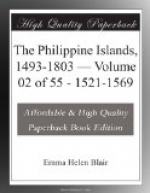Legazpi. The “San Lucas” separated
from the fleet December 1. On the eighth, Diego
Martin, pilot of the “San Pablo,” reported
land but he was in error. Next day an island
was sighted, in which there were “about one
hundred Indians, a people well built and with long
beards,” for which the island was called Barbudos.
“The women have pleasant faces, and these people
are as dark complexioned as mulattoes. The women
have little gardens. They have certain roots
from which they make excellent bread, for I have tried
it.” [63] On the tenth they passed and named
the islands Placeres and San Pablo. Other islands
were passed on the twelfth and fifteenth. On
the twenty-second they sighted a mountainous island
to the south, whose inhabitants saluted them as “chamurre,
chamurre,” [64] or that is, “friends, friends!”
This was the island of Guam. They found it to
have a good bay and good rivers of fresh water.
The products of this island are named, the people described,
and the troubles there briefly enumerated. “The
master-of-camp and Martin de Gueyte, with one hundred
and fifty men, sacked and burned two villages.”
During the eleven days spent here “masses were
said each day.” Numerous words of the language
spoken are recorded: Friend, chamor; good,
mauri; hereabout, baquimaqui; pleasant
to the taste, mani; take, jo; oil, rana;
rice, juay; land, tana; dry cocoa, micha;
senor, churu; fresh cocoa, mana; iron,
yrizo; botija [a species of jar], o;
gourd, coca; ship, botus; nail, yuro;
salt, azibi; sugar-cane, tupotipor; fish,
bian; no, eri; salt fish, azuiban;
yam, nica; small, segu; wood, tagayaya;
green banana, regue; water, ami; tamal,
enft; banana, jeta; acorn, puga;
net, ragua; pictured paper, tricabo-tali;
eyes, macha; rock, rapia; ears, perucha;
paper, afuipuri; teeth, nifi; palm-leaf
mat, guafal; hair, chuzo; ginger, asinor;
hands, catecha; she, reben; foot, ngmicha;
osier basket, pian; beard, mimi; deep,
atripe; leg, achumpa; crab, achulu;
this, achi; petaca [a leather covered trunk
or chest], agu; pitcher, burgay; come
here, hembean; star, vitan; moon, uran;
sun, afaon; to eat, mana; large, riso.
Their numbers up to ten are: acha, gua, tero,
farfur, nimi, guanan, frintin, gua [sic], agua, manete.
On the fourteenth of February, 1565, they sighted
the Philippines. Describing the natives, Rodriguez
says: “these Indians wear gold earrings,
and the chiefs wear two clasps about the feet....
All the body, legs, and arms are painted; and he who
is bravest is painted most.” Juan de la
Isla was sent with one of the small vessels to reconnoiter
a large and excellent bay at some distance away.




